Compliance with best practices. To maintain safe and ethical business operations, companies of every size in every industry must follow certain laws and regulations as part of business operations. Opting out of compliance is not an option. But the sheer volume of laws that companies need to follow makes regulatory compliance challenging and complex. In addition, regulatory compliance requirements for businesses are often changing, making it feel like shooting at a moving target.

Compliance With Best Practices
Failing to comply can prove costly in terms of legal and financial penalties and the consequences of eroding customer trust and tarnishing your reputation.
Determine Your End Goals
Rather than jumping into the first steps towards compliance, it is often a good practice to start with where one wants to end up and work back from there. In some cases, this could be a specific law or regulation that must be complied with to operate as a business. In other cases, it might be a solution to a specific compliance area that is imposing certain fines or violations.
Before doing anything, start by analyzing the result that needs to be achieved and identify those specific areas that need improvement. This involves looking at the goals and objects and identifying key results that matter to various stakeholders. It also means establishing clear metrics to measure how well those goals and objectives are being met.
Know Industry’s Regulatory Environment
It may seem obvious but knowing the regulatory environment of the specific industry is integral. Not every organization has the personnel or expertise to stay up to date with every piece of legislation and its requirements.
While some companies are fortunate enough to have a Chief Compliance Officer whose job is to know and implement this information, many organizations do not have a CCO. However, lacking a designated CCO is not an excuse. It does not exempt from needing to comply with laws and regulations. This means that people within the organization should be identified who can formally add these compliance responsibilities to their jobs.
It might be the case that someone new needs to be hired to handle them in a full-time role. Or an outside consultant or legal counselor may be engaged to eliminate risk.
Regardless of which option is chosen, every organization needs someone who understands the regulations that affect the industry and oversees internal compliance requirements.
Create Effective Policies and Procedures
Written policies and procedures are often used as a tool to help reduce regulatory risk.
The key to compliance lies in a company’s ability to manage, distribute, and track all these policies and procedures to ensure employees know and understand them. Then, the regulatory compliance best practices mean getting all of these expectations and requirements in writing for employees to know and sign off.
Hold Employees Accountable
Not every company requires employees to sign specific policies. But if employees are the first line of defense against non-compliance, being able to track what they received and acknowledge those policies could help reduce risk.
Solely relying on paper sign-off sheets or email read receipts might not suffice. Instead, a robust system that can quickly and easily track who has signed which version of which policy is needed. This allows collecting proof that the company has communicated to employees and what employees have acknowledged that they have received, reviewed, and understood.
Conduct a Compliance Audit
A thorough audit will always work well when following regulatory compliance best practices.
Once a CCO, a consultant, or a compliance team has been onboarded to handle risk management and compliance, they need to conduct a comprehensive review of all the regulatory compliance areas that the company needs to address.
In addition to assessing whether or not the business is meeting all these regulations, it is also important to establish a baseline of where compliance efforts currently stand. This includes determining how many violations the company has had, how much these violations have cost, and whether any at-risk areas could potentially be fined.
This baseline can also serve as a rationale for additional funding or personnel. For example, it makes sense to purchase a new piece of software or hire a CCO if it costs less than the fines would be for non-compliance.
Build a Comprehensive Document Repository
Everyone in the company should know exactly where to look for any compliance information they need to do their jobs.
The volume and complexity of compliance information can prove challenging to understand and retain. Relying on memory is a recipe for failure. Instead, employees need an easy-to-use resource that allows them to search for and find the information they need quickly and accurately.
Storing critical compliance documents in a binder is an outdated approach to document management. And cobbling together a system of spreadsheets and shared files often leaves gaps and plenty of room for errors.
Instead, it should be ensured that only the most up-to-date and accurate information exists in a document management system. Plus, this repository needs to allow employees the ability to search from anywhere, whether they are at work, at home, or out in the field.
Track Violations and their cost
Similar to the audit, the ongoing monitoring and tracking of violations serve as another compliance best practice. To get control of regulatory compliance, tabs on recurring and one-off violations need to be kept to reduce the chance that they will happen again.
This should also include monitoring the costs associated with these violations to see the impact of non-compliance on the company’s bottom line, productivity, level of customer trust, and reputation.
Like the audit, tracking violations and costs offer a good way to prove the ROI of additional risk mitigation measures. It can also help with holding employees accountable.
This does not mean that employees need to be punished for every violation. But, on the whole, if the specific cost associated with these problem areas can be monitored, it can act as a motivating tool for change to be able to improve and reduce risk.
Compliance Training
Policies provide the first line of defense, and training serves up the second, especially when compliance training aligns with the policies. Training reinforces the behaviors and processes that will be the most effective.
Doing so also helps increase comprehension and awareness in employees. In this way, policies and training are always working together to form a complete compliance solution rather than a patchwork system of efforts.
Communicate Clearly and Regularly
Written policies can serve as a powerful tool for regulatory compliance. Still, if employees don’t know about them, these policies might as well not even exist. That is why it is critical for leadership and those responsible for compliance need to communicate that information throughout the company.
Policies and procedures cannot live in silos, and leaders cannot assume that one memo or directive can fix the compliance issue.
Employee communication plays a vital role in putting regulatory compliance best practices to work in any organization.
Communicating what the issues are, what they mean for individual employees, and what needs to be done to correct them offer some of the most effective ways to fix problems and create a culture of compliance.
Regularly Review Your Compliance Program
Like any good program or plan, reviewing the efforts regularly helps spot weaknesses that can be improved. At a minimum, a compliance program review should be performed annually. However, the review might need to be done more often than that in some cases.
Regularly looking over the plans, documents, training, and violations and evaluating if everything is still current and effective will surely offer a perfect last step for compliance best practices.
Final Thoughts
A corporate compliance team’s primary responsibility is to develop compliance strategies and programs, as well as to implement processes and tools to identify, oversee, and mitigate compliance issues at the enterprise level. Furthermore, as regulatory compliance requirements increase, the corporate compliance team must collaborate with individual departments and regulatory teams to oversee compliance at the departmental level.








